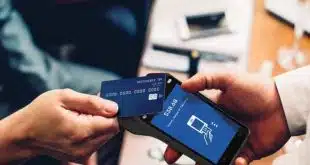So-called stickers, or chip-and-antenna inlays that can be affixed to mobile phones or other tokens to turn them into contactless-payment devices, are showing signs of developing from a novelty to a commercial product. CPI Card Group, a card manufacturer in Littleton, Colo., expects to ship “several million” bank-card-branded payment stickers over the ncxt 12 months, says Benoit Guez, director of product marketing for the company, without being more specific. “The market potential seems to be very good,” he says. CPI announced this week it is manufacturing the products from so-called prelams, or inlays, from Inside Contactless, a French chipmaker. Bob Clarke, vice president of sales and marketing at CPI, said in a statement the company expects orders from “several” major card issuers in North America. He also said CPI will deliver its first shipment to “a global leader in electronic commerce and payments services.” Guez won't name the customer, but adds CPI is in talks with around 10 financial institutions that have expressed interest in testing the stickers. CPI decided to proceed with the technology after receiving strong interest from attendees at a major U.S. chip card show this spring, Guez says. The company distributed contactless stickers to executives at 15 banks before the show and invited them to visit CPI's booth to try them out. The reaction from the visitors was very positive. “We never expected such a reaction,” Guez says. “We got such a good reaction from those guys we thought there may be something here.” CPI and Inside Contactless are not the only companies moving ahead with the sticker concept. First Data Corp. is promoting its Go Tag stickers and says it has had strong interest from a number of major retailers. Unlike CPI's stickers, which will work on the Visa Inc. and MasterCard Inc. contactless platforms, Go Tags are intended for private-label transactions. In addition, Heartland Payment Systems, a major acquirer, and Mobile Candy Dish, a mobile-service software company, have introduced similar technology over the past year. Contactless stickers are seen as a way of allowing handsets to perform point-of-sale transactions without the need to embed near-field communication (NFC) chips in the devices. Integrated NFC technology, though potentially a more powerful option because it works with the phone's operating system, has been slow in coming to market. “There's no question [stickers] are a bridge [to NFC],” says Guez. “Eventually, there'll be complete integration with the phone, but how long will that take? NFC is a fascinating product for the future but it's not there yet. The business model still has to be built.” Guez points out that there may be a market for stickers even after the commercialization of NFC. “Not everyone will be able to afford an NFC upgrade on a phone,” he notes. Still, stickers are neither cheap nor easy to make, Guez says. CPI receives the inlays from Inside and drops them on to standard card stock, then prepunches them for personalization and removal for application to a phone. The price of a sticker will come down as quantity builds, Guez says, but currently they are anywhere from 2.5 to three times more expensive than a contactless card. That puts the price to the issuer at around $3 each, he estimates. Contactless cards, he says, run from $1.10 to $1.20 each. Conventional mag-stripe cards cost around 50 cents. Despite the cost, the technology's versatility holds strong appeal, Guez says. It can be affixed to any phone, making it possible for users to leave the house without their wallets or purses, he notes. Consumers who lose their phones can deactivate the sticker by calling their banks. Compared to cards and fobs, stickers are “definitely more appealing than other form factors,” Guez says.
Check Also
Shift4 Concedes Some Shortfalls While Posting a 49% Rise in End-to-End Volume
Shift4 Payments Inc. reported a strong third quarter early Tuesday, but by some measures it …





